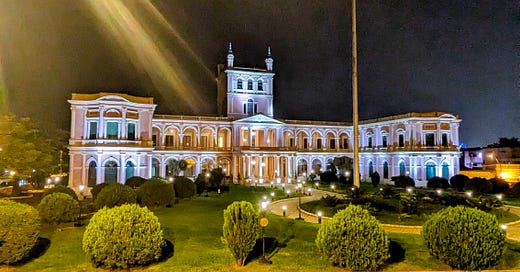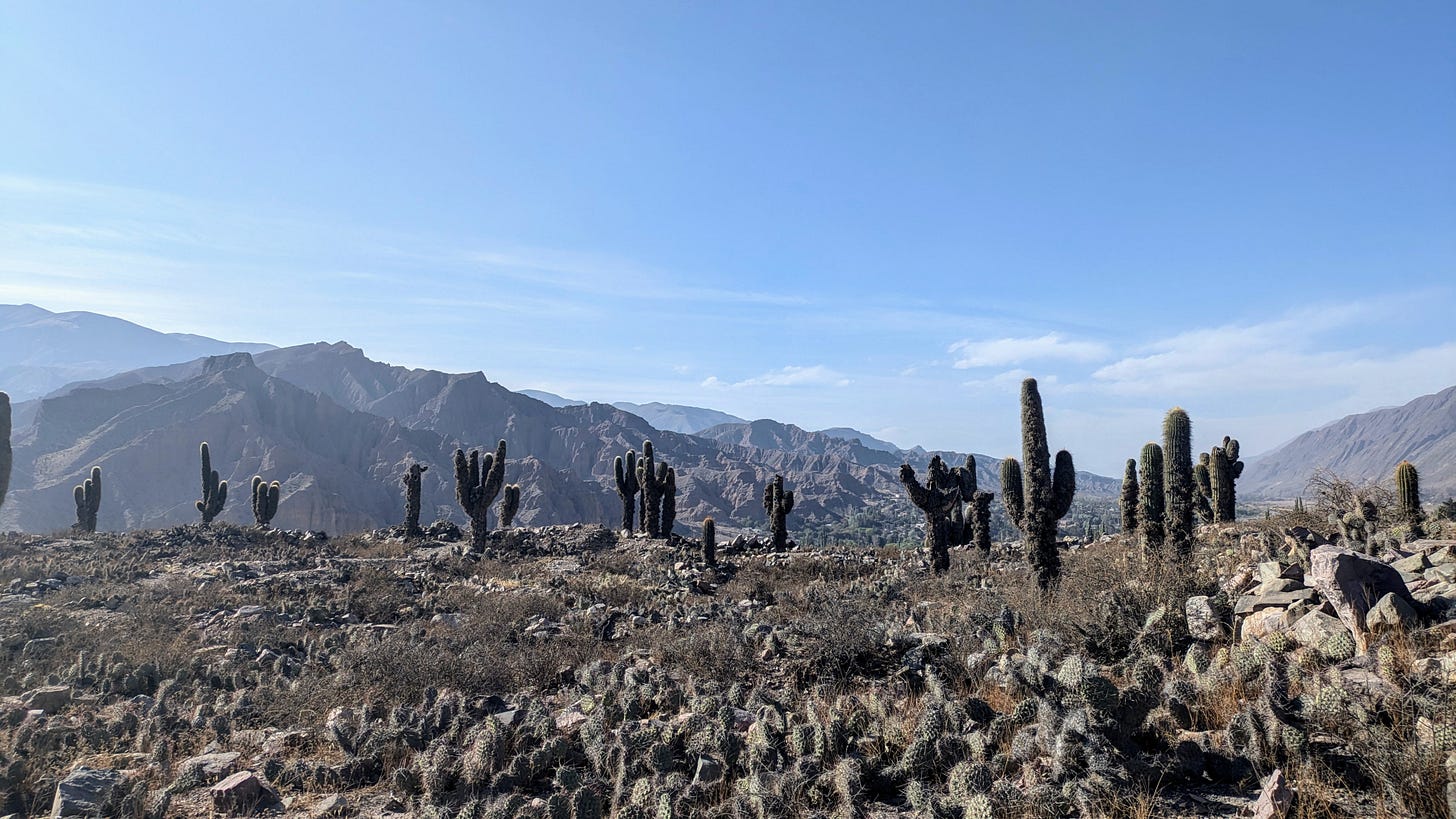A tale of two cities: Salta to Asunción
It was the hottest of times; it was the muggiest of times
In very unplanned, unexpected news, I write this as I wait for a flight back to London from São Paulo this evening. Even more unexpectedly, I write it from the Amex VIP Lounge at São Paulo airport, which I have somehow managed to blag my way into for free! I’m not exactly sure how it happened, but it’s possible this is the other side to being a woman on her own while travelling…
Don’t worry, I haven’t ditched Dave completely, and the backpacking is far from over. After an anguished few days of indecision last week I decided to make the impromptu trip back for a few reasons, but mainly to see a very dear friend get married. Expensive, yes, impulsive, a little, but I’m so excited to see people, drink tap water, take a bath, and have a proper cup of tea.
Before beginning this trip, I’d been feeling torn about the politics and practicalities of flying back home for something like a wedding, but reasoned that there would always be things we’d miss by going away like this, and, selfishly, after a few summers of non-stop weddings (I went to nine last year) I was looking forward to putting my own big plans first for a while. It’s a funny thing, being nomadic like this for so long. I mused with a friend on the phone recently that if Dave and I had simply pegged this trip as “moving-to” somewhere – Argentina, say – we’d have likely made at least one trip home in this time. But there’s something about backpacking – the distance, the lack of roots we have here on this continent, the need to keep going, keep discovering new things – that made it feel impossible to simply “pop back” without it signifying the end of something, of breaking the spell.
But then, chatting to my friend on the phone and hearing about her pre-wedding stresses, being reminded of the fact I know she’d love to have me there, and feeling every one of the 10,000km away from her and my other pals, it occurred to me that maybe travelling doesn’t have to be so binary. Yes, we’re doing what some people would call a “once in a lifetime” trip (not for me: I plan to do it again I’m afraid) and hitting plenty of “bucket list” sights (a phrase that makes me feel weary) but maybe there is also a once-in-a-lifetime opportunity in flying back for a week in the middle of a long trip to do something fun for a friend.
At the other end of this scale are the travel influencers I see on Instagram who fly absolutely everywhere and almost always to individual places with time at home in between. Is this the difference between travelling and simply taking lots of holidays? Discuss. Either way, it must waste a lot of time going back and forth so much. It also makes for a terrible carbon footprint, which is something I do think people should be mindful of if travelling is literally their job. I’m thinking of two separate US couples on Instagram in particular, whose respective content I do very much enjoy. Both couples have been travelling full time for three years or more, and their itineraries are bonkers: it will be Brazil to Scotland to Japan to France, or from their home in the US to France, back home to the US and out again to Germany. Where’s the logic in that? I’m not suggesting my own carbon footprint is perfect, but it’s got to be a lot smaller this year from all the ground-based travel we’ve taken.
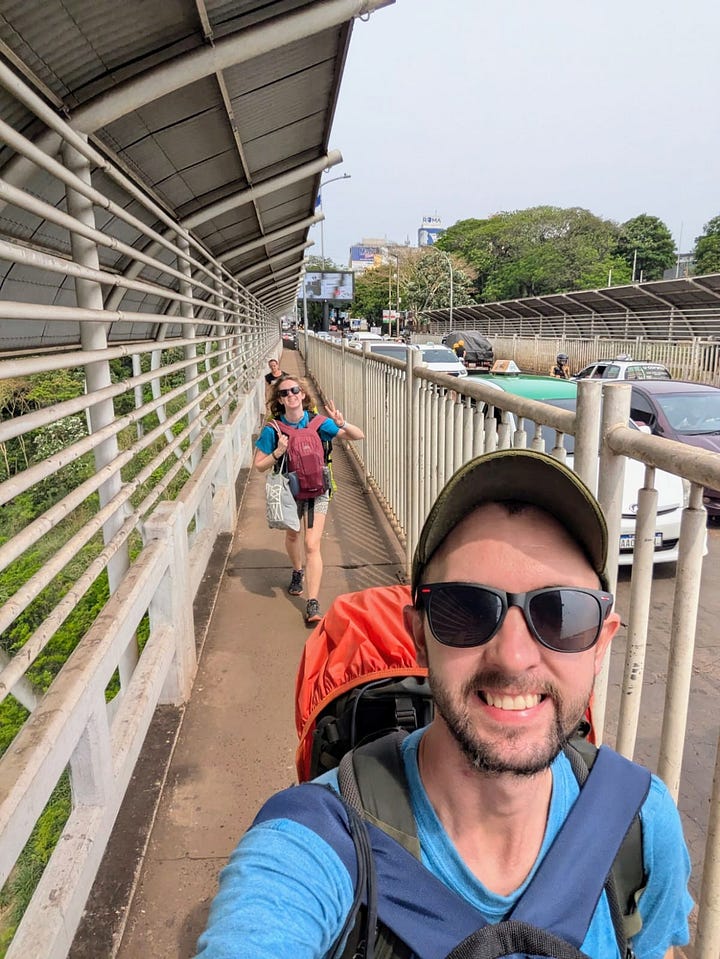
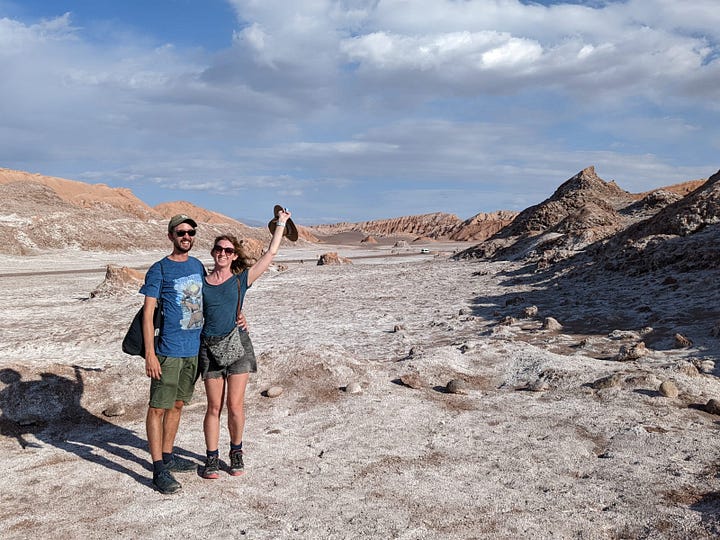
It was only when arriving at the airport today that it occurred to me this is the longest time I’ve spent away from the UK. Even when we lived in South Africa when I was younger we popped back for Christmas and the school holidays. And the truth is, as much as I miss my friends and London things in a gentle way, I don’t miss home enough – yet – to want to come back for good. I am sure that is helped by the fact I’m travelling out here with Dave. The time goes faster when you’re sharing things with someone else, and I think we also provide that little emblem of “home” for each other that makes it easy to relax into the strange and foreign and forget about what we might be missing back in “normal” life.
It will be an interesting couple of weeks for Dave on his own in Londrina, a city chosen for its convenient proximity to São Paulo but crucially for being somewhere new and more interesting than São Paulo. (It also happens to have been named in honour of London, which is pure coincidence and allows him to live his own faux “London” life in the John O’Groats Scottish pub.) Interesting given that it’s a last-minute and unexpected thing but also because, I have just learned, he’s never spent this long on his own before. I’ve promised him I will be back – my return flight is booked and in any case, he’s stuck in Londrina with most of my belongings – and I’m nudging him to write a guest post for me on the things he gets up to during my absence…
From Humahuaca we continued down through the Quebrada valley to Tilcara, stopping off in the tiny desert town of Uquía for lunch on the way. We were intrigued about Uquía after reading about its church, which is not a sentence you’ll often hear from me, but this church is unusual: the angels featured in the 17th century paintings that line its walls are all armed. And I’m talking serious metal – big hefty guns befitting of a guerrilla army. You’re not supposed to take photos but much like the angels I rebelled while Dave distracted the weary church overseer at the back.
Arriving in Tilcara later that day, the vibe became suddenly more upmarket, befitting of Salteña weekenders taking a break from the city. While we welcomed the prospect of going out in the evenings to eat in nice restaurants with other people in them and a little more atmosphere, I did miss the simplicity and unpretentiousness of Humahuaca.
Tilcara’s surroundings are still beautiful of course, and I didn’t begrudge the chance to visit the handful of crafty boutique shops and point at things in a faux-passive way, aware that my birthday was coming up (a very fun and artsy llama ring and t-shirt, thanks Dave).
Our accommodation in Tilcara was also fun: an old convent turned hostel, complete with all the original features and resident ghosts. The nuns who once lived there were long gone, I should add; these days the place is owned and run by weed-loving hippies along with their pet dogs, cats, llama and alpaca. It was also a hell of a lot cheaper to stay there than anywhere else we found.
The main tourist draw in Tilcara, asides from the usual stunning rock formations and surrounding valley, is the ancient Pucará de Tilcara settlement. The site dates back as far as the 12th century, but it eventually became a military outpost for the Incas in the late 15th. Then a bunch of university busybodies came along in 1911 to clear the site of its treasures, and overzealous archaeologists rebuilt some of the original Inca buildings to an approximation of what they used to be.
We’d been warned that this one was Quite Badly Done, and the guidebooks didn’t lie. I’m sure the site was impressive once upon a time, certainly for its position up high on the rock, looking out across the valley. But one gets the impression that even the department of tourism doesn’t share much love for the reconstructed mess that is the remaining site, complete with huge, self-congratulatory cement memorials praising the archaeologists who destroyed it. But it was nice enough to walk around and consider the views: Quebrada on one side of town, hideous working quarry on the other. Which is probably just how the Incas would have had it to be fair – those lads were big into quarrying stone, which they dragged up mountains by hand using ropes and wooden rollers to build their empires.
From Tilcara, we spent a very pleasant afternoon in the neighbouring town of Maimara, which we reached by joining a queue of school kids taking part in an ingenious community car-share system. It sounds like I’m describing Uber, but I assure you it was much more quaint than that. Let’s just call them shared taxis. (Come to think of it, were we actually just jumping in their parents’ cars coming to pick them up for lunch? Unconfirmed).
We’d planned to treat ourselves to a lunch and wine pairing at the Bodega y Viñedos Jesús Vilte, a splendid looking little wine producer, but when we arrived it was completely closed up, zero signs of life. A pity, but not far along the road we stumbled upon Maima Café Resto Bar, where we shared a bottle of red and a platter of meats and cheeses. The afternoon became hazier, but I do remember the chef coming out to see us at one point to tell us that she loved King Charles and Queen Camilla, and please could we pass on her best wishes?
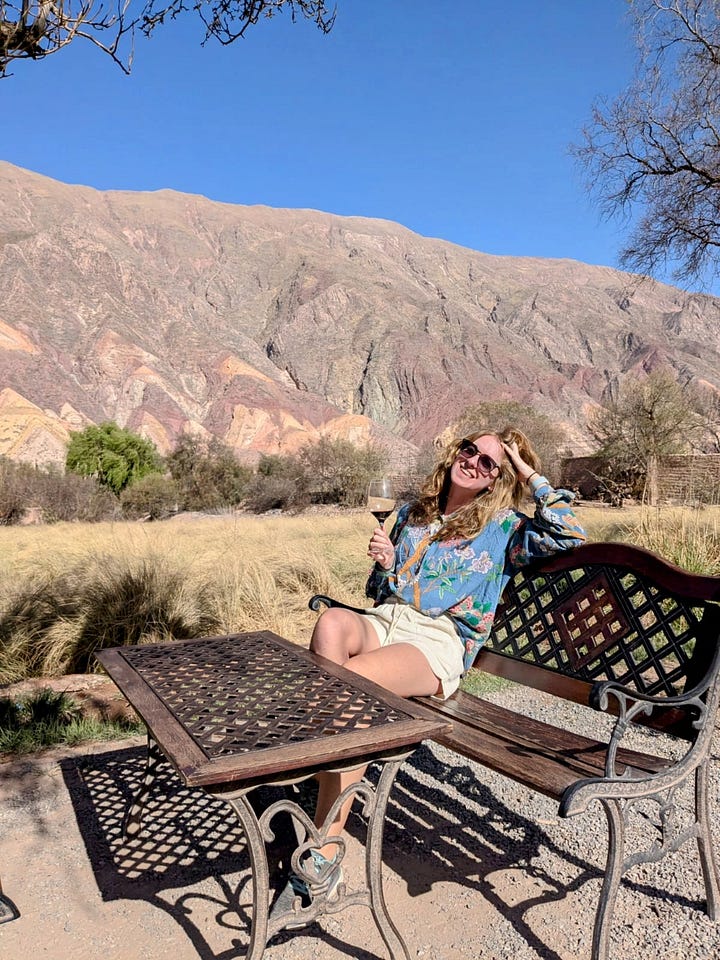

Onto Salta, our last stop in Argentina for this trip. Salta was a good place to lie low for a few days and recuperate, by which I mean drink far too much wine, have another meltdown about my hair and convince Dave to cut my mullet tails off for me. Meanwhile, Dave took a chance on a lamb empanada in the posh Patagonia taproom and spent 24 hours vomiting his guts out from catastrophic food poisoning (and not always making the bathroom of our Airbnb). So maybe not all exactly as we planned it, but a worthwhile trip all the same.
We first visited Salta in early December last year, towards the end of our second loop around Argentina. It’s a beautiful city and interesting for its mix of huge stone Spanish architecture and distinctly Andean culture – very different to that of Buenos Aires and Argentina’s other major cities. The wine in this region really is the best (Cafayate for me) and being in the Andes means the food becomes a little spicier and more veg-friendly. It’s usually an excellent place for empanadas, famously the Salta “salteñas" – the salsa is picante and the pastry oven-baked – but I’d steer clear of the Patagonia ones if I were you.
In the days counting down to our arrival, we’d been typically relaxed about finding accommodation – Salta’s a huge city with far more Airbnbs than tourists, at least that was our experience last year – but when I started looking for a place with a couple of days to go, I got a shock to find there was barely anything available, for any budget.
Salta also happens to be the place I found my Spanish teacher, Graciela, and when I mentioned this predicament to her during our online lesson, she told me: ‘Oh, its the Fiesta del Milagro, hundreds of thousands of crazy people will be arriving – I usually try and get out of the city, or hide in my house until they’re gone.’
I don’t know if it’s just coincidental that Dave and I always somehow manage to accidentally time our stays for that particular region’s religious festival / local day of oddity, or maybe there are just an extraordinary number of such days in Latin American countries. The “feast of the miracle” was a big one, by any standards: hundreds of thousands of pilgrims walk over 100 miles from across the Quebrada and Andes, and many more visitors travel in from across the continent to witness the final parade. Of the hikers, I read that every year at least one person dies along the route, most likely from heat stroke and exhaustion.
On Sunday, the big day, the city centre was all but closed save for the impressive cathedral, and we timed our walk into the centre just as the crowds appeared: clergymen, dozens of them, followed by thousands of pilgrims; an enormous effigy of Jesus being carried by footmen and flanked by men carrying 10-metre high grabby-sticks, whose job it was to lift up the trailing power lines as Jesus made his way under them. It was an impressive feat of organisation. This year there were apparently 650,000 pilgrims – more than the population of Salta – though I’m not sure it warranted all the armed riot police lining the pavements. For what it’s worth, we did manage to find a nice and affordable Airbnb just outside of the city centre, it’s just a shame Dave christened it with sprays of half-digested empanada everywhere during his own midnight ceremony.
As much as I’d loved to have spent longer in Argentina and head west to the wine valley again, Dave and I were feeling the pressure of the seasons. Every day as the temperatures rose through the high 30s and into the 40s, we knew we didn’t have long before the weather broke and the rainy season began. As I mentioned last week, this would be bad news for our flexibility in Paraguay, and so after a week in Salta we took a 12-hour bus overnight to Resistencia on the Argentina-Paraguay border.
There’s always something a little bit pitiful about our final moments in each country, scrabbling together the few pesos we have leftover to try and spend them all, and this time was no different. While we waited for our onwards bus across the border, I enjoyed a solo omelette at the bus station café while Dave sat across the terminal with a pastry from a separate, cheaper kiosk, and then we went to the ticket office to buy tickets from an Argentinian man who said he’d been to Liverpool in the 1980s while working in the military. I asked him what he’d seen and if he liked it, he said he remembered being very impressed by the traffic light system in Liverpool, and how cars would stop to let pedestrians cross the road. Neither of us mentioned Las Malvinas.
From time to time during our really quite drawn-out conversation (during which ticket man drew me a picture of a crossroad to keep), he would point at Dave and say something like “he really doesn’t speak the language, huh?” before shaking his head in disgust and complimenting me on my hair. Tickets secured and new friendship cemented, we said goodbye and Dave and I boarded the bus to Asunción. As we stopped at the border crossing, the heavens opened right on queue, but the crossing itself was laughably straightforward. I don’t think anyone has any trouble smuggling goods across South American countries.
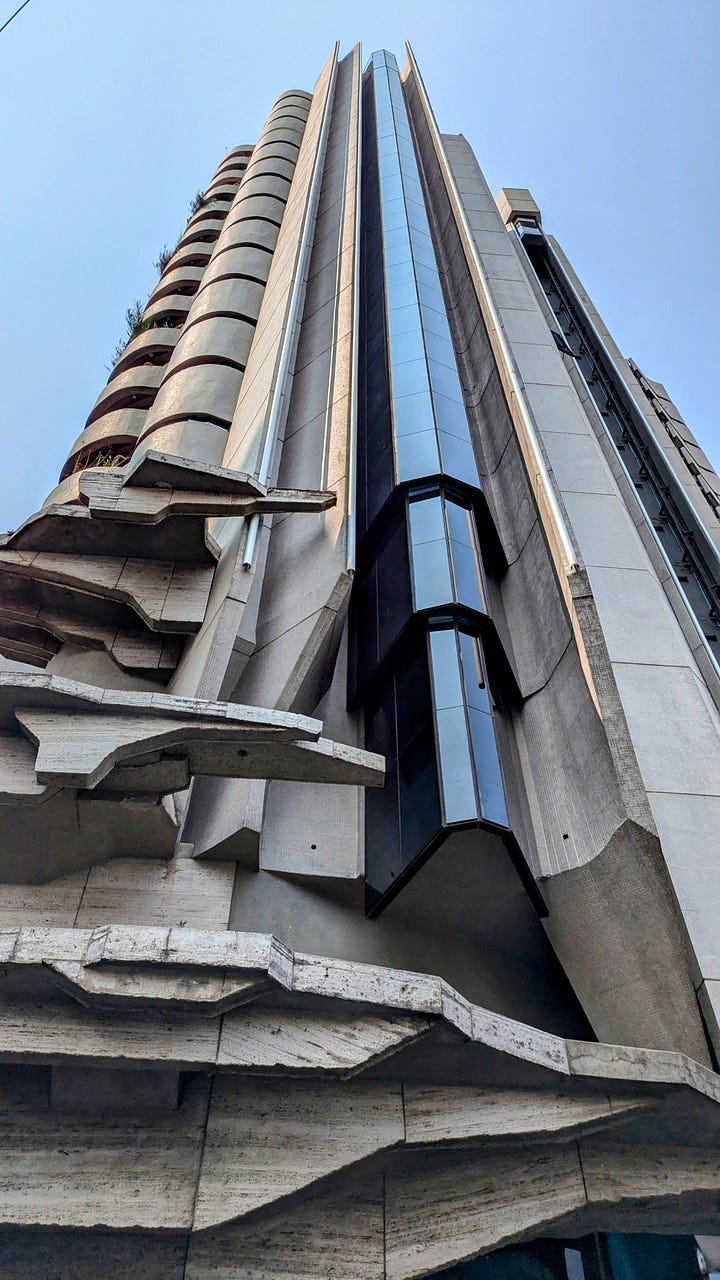
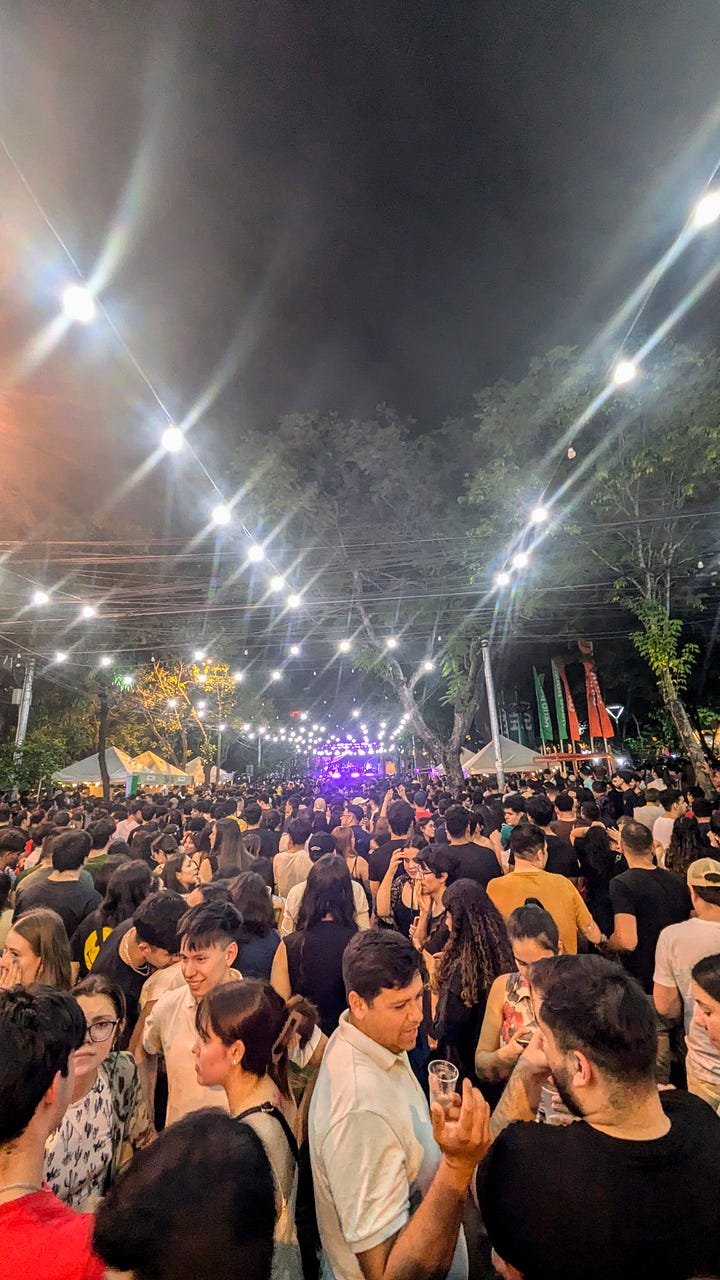
I didn’t know what to expect for Paraguay. It’s not one of big hitters for tourism in Latin America and I wonder if that’s a cause or effect of the fact there’s very little information for tourists online or in the usual guidebooks. Our Rough Guide: South America on a Budget bible for example only has a dozen pages for Paraguay (the section on Argentina has 112 and Brazil 142) and I strongly suspect that the author hasn’t actually visited any of the places in it apart from Asunción. We don’t tend to rely too heavily on the guidebook, generally speaking, but it’s usually a good starting point for researching the big must-see sights. In this instance, the writer has really phoned it in. For example, a central page to the Paraguay section is titled “Paraguay's hard-to-reach natural wonders” and simply lists all the places that would be nice to go to if you can work out how, but gives absolutely no more information as to how to get there.
We knew we wanted to try and get to the Pantanal, but we didn’t know if it was still on fire, or if with the dry riverbeds it would be fully worth us making the journey at this time. On the one hand, if it did suddenly start raining torrentially, the roads could become impassable and we could get stuck there. We figured we’d settle in Asunción for a few days first and make a plan from there – in any case, it’s often easier to understand the possibilities of a place once we’ve arrived at the bus terminal and can see what transport routes exist from there with our own eyes. At the end of this stage of the trip I’ve decided I’m going to make it my mission to better promote the tourism possibilities of Paraguay. If Rough Guides wanted to pay me for it, that would be ideal.
Maybe it helped going in with no expectations, but I thought Asunción was fantastic fun. Unlike most other Latin American capitals, its architecture is often boxy and unassuming. It’s not huge, and the traffic is a lot. But there are so many interesting little pockets of cool to happen across.
I’d heard that the city centre is quiet on weekends, but on our first day there, a Saturday, Dave and I walked into the centre to stumble upon a huge festival in celebration of the first day of Spring, with craft stalls and bands playing on a stage, surrounding bars and restaurants absolutely heaving with people. Even with the crowds it was a nice atmosphere – I get the impression Paraguayans are quite gentle folk compared to their neighbours in Argentina or Brazil.
We pottered about the main square and visited the Panteon Nacional de los Heroes, an impressive memorial building with the coffins of several dead presidents and one dead poet housed in the centre. We also stopped by the historic train museum, a converted railway station back from when the Brits had a brief go at getting Paraguay on the railway network. What was interesting, apart from seeing all the “Made in Birmingham” stamps on the old machinery, was the messaging regarding historic British presence in Paraguay. The Brits come across very positively (really not something we’re used to Latin America/ the wider world) on account the fact they defended Paraguay during the War of the Triple Alliance – ie, when Brazil, Bolivia and Argentina ganged up on little Paraguay during the 1860s.
From the centre, Dave and I walked out towards the river, pausing at the Presidential Palace (described as a bit gauche by Rough Guides, actually rather lovely we thought, but what does that say about us?) before heading out for a stroll along the Costanera boardwalk and through the port and cultural centre. Near the port is a neighbourhood called Loma San Jeronimo, which used to be rough but was jazzed up a few years ago by artists as part of a community renovation project. Today there are murals, a handful of shops and bars popping up, and a colourful, tiled staircase – like a much smaller and quieter version of Rio de Janeiro’s Escadaria Selarón, but without any of the queues.
There’s plenty more to say about Asunción, but – spoiler – we’ll be back there again in newsletters to come and in any case I’ve had just too much free champagne from the Amex lounge bar now to concentrate on that. New focus: don’t miss my flight.
Travel bits and tips from this week
From Humahuaca we took the local bus south towards Tilcara, hopping out at Uquía to see the armoured angels.
There’s no official bus station at Uquía, so we planned to wait at the side of the road after lunch at and flag a bus down to continue our journey to Tilcara. Fortunately a huge tourist coach arrived within minutes and allowed us to squeeze on with our big bags very happily.
In Tilcara we stayed at El Convento, a charming old convent building turned hostel. It was cheap and came with a shared kitchen and a garden full of dogs and camelids.
The ancient site we visited was the Pucará de Tilcara, which I wouldn’t bother going back to – there are much better (and more authentic) ruins to see around the valley if you have time to explore.
We took a shared taxi to the neighbouring town of Maimara, where had a very lovely and boozy lunch at Maima Café Resto Bar.
Later that same day, back in Tilcara, we checked into a cervecería (that I can’t find on the map) for happy hour and went for another fancy meal at Senador Tilcara (I know, who do we think we are?). Another evening we enjoyed a sharing platter at Khuska.
In Salta we stayed at this Airbnb which was perfectly nice until Dave vommed everywhere. Also the building had a pool with no water in, which was sad.
Too many food and drinks haunts to name in Salta, but we spent an idyllic couple of afternoons sampling the wine at Bodega Caseros, just off the main square. Factury was a great outdoor spot for brunch, cakes and pasta. And on Sunday night when not many things were open, we had the most delicious meal at veggie restaurant Cardamomo.
We searched high and low to find a cute traditional empanada restaurant we’d been to last year called La Criolita. Turns out it has been renovated to become La Nueva Criolita and is no longer as charming. But we did have a stack of empanadas for pennies each and they were great.
Dave got food poisoning at Patagonia tap room. 👎
We took an overnight bus from Salta to Resistencia and on to Asunción across the border later that morning.
I loved our apartment in Asunción – huge kitchen, outdoor seating area, good air conditioning (crucial), with mid-century decor.
Close to the Airbnb was a café called Confiteria Honey which did very mediocre brunch food, quite a fun daily lunch buffet, and had vast patisserie counters. We went there several times on account of its proximity to the flat and strong wifi.
We also ate at: Koggi (cool, relaxed Korean restaurant/bar place with good bibimbaps); D'Alessandro Pizzeria (the best pizza in months; very Hackney, east London vibes, aka, located in a shed); Café Consulado (great coffee and salads); the famous Lido Bar and the institution that is Bolsi – both traditional counter-service restaurants in the centre of town; Taberna Española (ok paella, incredible 16th-century vibes), among others.
Just a couple of streets away from our apartment was Jardin Urbano – again, a very fun if slightly Hackney aesthetic.
Guarani Lounge was the understated bar we found in Loma San Jeronimo with a view across the river, and we had astonishingly cheap drinks at the very hip downtown Check Point Bar, as well as Casa Clari, which overlooks the presidential palace.

